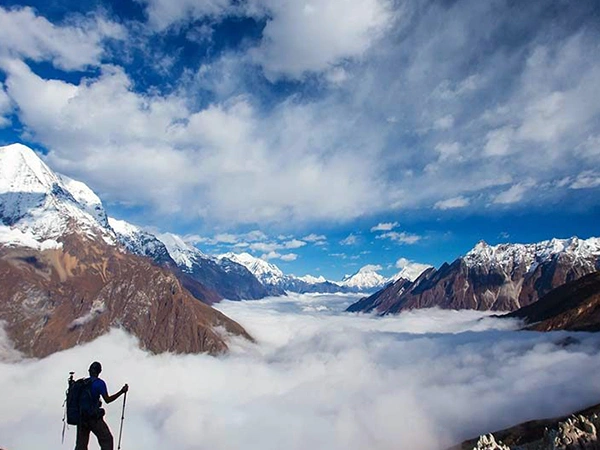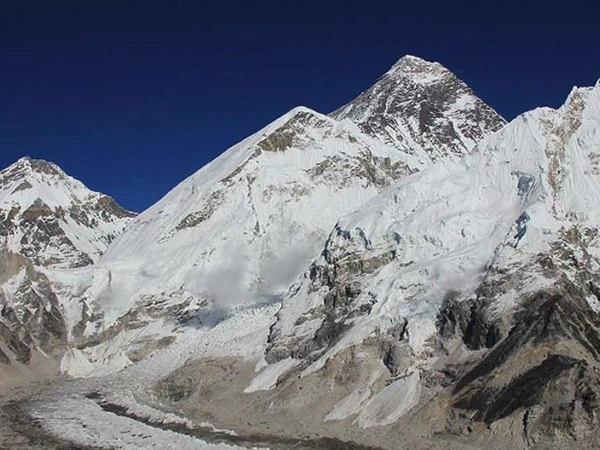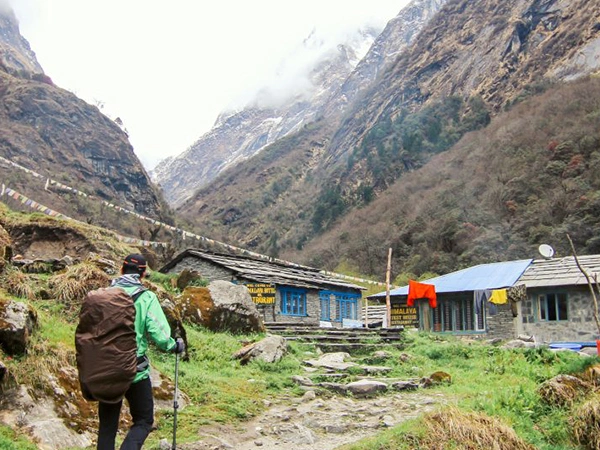Everest Base Camp Trek is a fascinating adventure that offers mesmerizing views of the pristine vistas of the Khumbu Region. During this incredible journey, you will get a chance to witness the beautiful views of Mount Everest (8848.86 m), which is the highest peak in the world, Lhotse (8516 m), Pumori (7161 m), Thamserku (6608 m), Cho Oyu (8188 m), and many other surrounding peaks. In addition, the unique landscapes, pristine glaciers, and serene rivers of the Everest Region add extra charm to the journey. Selecting the best time to go to Everest Base Camp Trek presents enchanting sceneries and exhilarating experiences.
Spring, Autumn, Summer/ Monsoon, and Winter are the four main seasons in Nepal, and among them, Spring and Autumn are considered the best times for Everest Base Camp Trek. In the autumn and spring season, the trails are dry, the temperature is moderate and the weather is stable, which has made these seasons stand out as the ideal times to embark on the journey.
During the Everest Base Camp Trek, you will walk through different beautiful places like Lukla, Phakding, Namche Bazaar, Tengboche, Dingboche, Lobuche, and Gorakshep. Every stopover point offers magnificent and unique sceneries. Furthermore, many trekkers opt to hike to Kala Patthar for sunrise and the clearest view of Mount Everest.
When you select a favorable time, you can trek through these places conveniently and smoothly and also get to enjoy the surreal beauty of the Everest Region while also getting a chance to connect with nature on a deeper level.
In this blog, let’s learn about what Everest Base Camp offers in every season.
Everest Base Camp Trek During Each Season
Spring (March, April and May)
Spring is one of the most preferred times for trekking to Everest Base Camp. The forests of the Everest Region are decorated with blooming vibrant rhododendrons. The landscapes are lush and adorned with beautiful wildflowers, which makes your whole journey delightful. The trekkers can have a comfortable walking experience as the temperature is mild and the atmosphere is pleasant.
The trails are dry and you can navigate easily while getting immersed in the serenity of nature. The fewer clouds in the sky allow you to witness the unobstructed views of the breathtaking vistas of the Everest Region. The bright days offer mesmerizing and clear views of deep valleys, hills, serene rivers, and snowy mountains, which elevates your sightseeing experience. The stunning views of sunrise and sunset from the vantage points are phenomenal. All these aspects have made spring the first choice and the most recommended season for Everest Base Camp Trek.
Some Tips for Everest Base Camp in Spring
- Stay hydrated and maintain a balanced diet.
- Book the trip in advance to secure good accommodation.
- Pack all the essentials.
- Even though the temperature is mild, higher zones can still be chilly, so it is highly recommended that you pack warm clothes.
- Trek gradually and incorporate acclimatization days to adapt to the changing environment
Autumn (September, October and November)
Autumn is also considered the best time for trekking. This post-monsoon season offers clear views of the mesmerizing landscapes of the Everest Region. The weather is dry and stable, which creates a favorable trekking environment for the trekkers. The air is crisp, and the landscapes are rainwashed in the previous monsoon season, which makes the whole trekking experience delightful. The temperature is moderate, the days are sunny, and morning and night times are cool, which is truly rejuvenating.
Embarking on Everest Base Camp Trek in autumn rewards you with crystal clear views of the alluring peaks like Everest, Lhotse, Ama Dablam, Pumori, and many more surrounding peaks. The visibility is excellent and it provides you a chance to capture the beautiful pictures of the verdant hills, serene rivers, and majestic landscapes of the Khumbu Region.
Trekking in autumn provides you with an opportunity to get cultural insights and witness the celebrations of many festivals. Mani Rimdu is celebrated with great enthusiasm in the Everest Region, and it falls in the autumn months of October and November. The festival holds great significance to Sherpas, and you can get a chance to witness the unique traditions of the region if you choose to trek in autumn.
Tips for Trekking in Autumn Season
- There are chances of rainfall in September, especially the first two weeks, so make sure to pack rain gear when trekking.
- Reserve the accommodations in advance as it is peak season and trails are crowded with trekkers.
- Autumn is considered the best for photography, so capture beautiful pictures of the ethereal landscapes and pristine snow-clad peaks of the mountain region.
- Trek through designated routes only.
Breakdown of Off-Season Months
Summer/ Monsoon Season (June, July and August)
Summer/ Monsoon is considered off-season for trekking. During the summer/ monsoon season, the trails are slippery because of the frequent downpours, and traversing can be challenging. The monsoon clouds cover the skies, and the visibility can be reduced. The trails are wet and muddy, increasing the possibility of slips, falls, and injuries, so every step should be taken gradually. The water levels in the rivers and waterfalls rise during the summer/ monsoon season, so you have to be careful when crossing the rivers and bridges. In addition, in the forested areas of the Everest Region, leeches and bugs are present, which can create an unpleasant experience for the trekkers, So carrying insect repellent is important. The weather is generally warm in the summer/ monsoon season, especially in the lower zones, but it cools down during the rainfall, so packing warm clothes is crucial
However, there are also many pros to trekking in the summer/ monsoon season. The trails are quiet, and you can enjoy the views while walking through the tranquil paths and feeling the peacefulness of nature. The landscapes are lush, and when the weather clears up after the rainfall, the distinct views of the alluring snow peaks and verdant hills are seen, which is fascinating. The sounds of flowing rivers along the trail captivate you with its soothing melody.
The skies, covered with ethereal cloud formations and mountains covered with mist, are one of the unique scenery seen during the summer/monsoon season that mesmerizes many trekkers. It is important to note that you have to be well-prepared with rain gear and well-informed about all the challenges that come along if you plan to embark on the journey in summer/monsoon.
Tips for Everest Base Camp Trek in Summer/Monsoon
- Make sure to pack rain gear and quick-drying clothes
- Monitor the weather and take advice from the guide before starting the trek.
- Be flexible with your itinerary, and be ready for adjustments or modifications in your scheduling.
- Be careful when passing through the steep and narrow slopes.
- Trek wearing waterproof hiking boots.
Winter season (December, January and February)
During the winter season, the Everest Region is the coldest. The terrains, especially in the upper zones, are covered with snow. The picturesque scenery of the snowy mountains and landscapes can be seen, which elevates your sightseeing experience. Trekking to Everest Base Camp in winter can be the ideal choice for those who wish to trek in a less crowded season in a tranquil atmosphere. The mountain views are crystal-clear in the winter season as there are fewer clouds in the sky, and the views are unobstructed.
However, embarking on the EBC Trek in winter also comes along with challenges. As the region is coldest, and the terrains are blanketed with dense snow, traversing can be difficult. Similarly, the temperature drops significantly during the winter months, and dealing with the cold can be strenuous for some. Additionally, navigating through the snowy terrains requires more effort and extra caution, as the presence of snow can make paths slippery. So, you need to be well prepared, and the trek can be manageable and completed smoothly with proper preparation.
Tips for Everest Base Camp Trek in Winter
- Winter days are shorter, so you should start the trek early in the morning.
- Pack warm clothes and dress in layers for a comfortable and secure journey.
- Always check the weather forecast, and do not trek in adverse weather conditions.
- Make sure to pack high-quality sleeping bags as it helps to ensure comfort and warmth.
- Maintain Proper hydration and make sure to have nutritious food in your diet.
- Make sure to gain valuable insights from guides, especially when navigating through the snowy and steep sections.
- Have a positive mindset and stay motivated.
- In case of any difficulties or discomfort, communicate with the guide immediately.
The temperature of Everest Base Camp Every Month
| Months | Day Time Temperature | Night Time Temperature |
| January | -20 °C to -10 °C | -15 °C to -20 °C |
| February | -15°C to -5°C | -15°C to -5°C |
| March | O°C to -10°C | -10°C to -15°C |
| April | 5°C to -5°C | -8°C to -10°C |
| May | 7°C to 18°C | 0°C to -5 °C |
| June | 0°C to 20 °C | -1°C to -3°C |
| July | 10 °C to 20°C | 2°C to -2 °C |
| August | 15°C to 10°C | 5°C to -2°C |
| September | 8 °C to 15°C | 6 °C to -2°C |
| October | 7°C to 5°C | -8°C to -10°C |
| November | 0°C to -10°C | -15°C to -12°C |
| December | 4°C to 10°C | -10°C to -14°C |
Accommodations Availability
There are several teahouses and lodges along the trail of Everest Base Camp. Most of the teahouses and lodges along the trail offer a clean and cozy room, a comfortable bed with blankets and a pillow. The facilities can get basic as you trek in the higher zones, but your stay will be comfortable, and the warm hospitality of the hosts will warm your heart. Accommodation availability also depends hugely on the season. During the peak season of Spring and Autumn, travel enthusiasts from all around the world visit Everest Base Camp, so if you wish to secure a good accomodation, then you must make advance reservations.
Similarly, inquiring and ensuring the availability of accommodation is also highly recommended in winter and summer/monsoon seasons. Even though they are relatively less crowded than the peak seasons, the prior reservation ensures a comfortable stay.
If you choose us to embark on Everest Base Camp Trek then we will be responsible for arranging all the accommodation facilities and you will have the best experiences staying in the finest tea houses of Everest Region.
Gain Insights On:
- 3 Day Trek To Everest Base Camp
- Everest Base Camp Trek 5 Days
- Everest Base Camp Trek 7 Days
- Everest Base Camp Trek 8 Days Itinerary
Altitude Sickness
When venturing into high-altitude adventures like trekking and expeditions, the risk of altitude sickness is always a concern. Throughout the trek, you will be in different high-altitude zones, and your body needs to get accustomed to changing elevation points. When your body can’t adapt to the changing environment, then there is a possibility of experiencing altitude sickness. It is also important to understand how your body is reacting in the changing altitudes. Headache, exhaustion, dizziness, lack of appetite, nausea or vomiting, and difficulties in sleeping are the major symptoms of altitude sickness. However, you can follow preventive measures to minimize the risk, like incorporating acclimatization day to let your body adapt to the changing altitude points, maintaining proper hydration, and taking gradual ascents. There are also medications available for the prevention of symtoms of altitude sickness, which can be taken after consultation with your doctor before embarking on the trek.
Factors To be Considered for Choosing the Time for Everest Base Camp Trek
Safety
Safety should always be considered first when selecting a time to trek. During the high-altitude trek, you will be traversing through the diverse and wavy terrains, covering long distances by foot. While the journey is adventurous and rewarding, there are also safety factors that should be considered. As the weather is stable and the possibility of the occurrence of any unforeseen events is considerably low during the autumn and spring seasons, they are considered the best time to go to Everest Base Camp Trek.
Interest and Preferences
You should select the right time, considering your interests and preferences. Every season is beautiful in its own way. So, you should select a season considering what the goals are or what you have visualized to see during the trek. If you wish to trek when you can witness the mesmerizing and clearest views of the mountains in favorable weather conditions, then the autumn season can be the ideal time for you to embark on the trek. If your interest lies in witnessing the vibrant blooming wildflowers in the valleys and forests, then you can go trekking in Spring Season. Trekking in summer/monsoon offers enchanting views of lush landscapes, and winter offers a serene environment with paths covered with snow. You can do detailed research about what each season has to offer and select the time as per your interest and preference.
Crowd Level
The impact of crowd level is huge when determining the right time to trek. If you want to have an interactive journey, then you can choose to trek in the peak seasons, as there will be many people on the trail, and you can have an intriguing journey sharing your stories and experiences. Autumn and Spring are the ideal times for treks and expeditions in Nepal. The crowd level is huge, and securing good accommodation can be difficult, so advance reservation of the trip is highly recommended
During the summer/ monsoon season and winter season, there aren’t many people on the trails, and you can enjoy the views and immerse yourself in the serenity of nature.
Fitness Level and Experience
Personal fitness level and experience are very important factors to consider when selecting a time to embark on the Everest Base Camp Trek. Traversing in the Autumn and Spring seasons is considered ideal because of the favorable trail conditions, which makes navigation relatively easier than in the off-season. The trails are dry during these seasons, and the temperature is mild, which makes traversing more comfortable and enjoyable, so a person with a good level of fitness and little hiking experience can complete the trek smoothly. However, during summer/monsoon season, the trails can be muddy and slippery, which may require extra effort to pass through the challenging and steep sections. Similarly, in winter, navigating through snowy pathways can be difficult for inexperienced hikers, which can affect their trekking performance. Trekking in the off-season also requires a lot of preparation and physical endurance. So, you should be aware of your fitness level and experience and select the right time, considering which time is favorable to complete the trek smoothly.
Trail Conditions
You should be familiar with the trail conditions of the Everest Region before choosing a time to trek. When you know what the trail is like in each season you can determine which season is the best to embark on the journey. There are certain challenges that come along in every season, and when you know about the conditions of the trail each season, you can make an informed decision. During the autumn and spring seasons, the trails are dry, which makes trekking comfortable and enjoyable.
Trekking can be challenging in summer/ monsoon seasons as the trails are muddy and slippery, and you will have to be extra cautious while taking care of every step. Similarly, the winter pathways are snowy, which requires careful navigation. So, it is highly advisable to research in detail, take suggestions from the tour operators, be well-informed about the trail conditions, and make decisions wisely, considering all the high points of each season.
Weather
Weather factors should be highly considered when selecting a time to trek to the Everest Base Camp. When the weather is clear and suitable, you can enjoy the ethereal views of the landscapes. Similarly, you can have a comfortable and enjoyable traveling experience when the weather is optimal. You will be able to reach the desired destination in time and also get the maximum perks while trekking. So, before selecting a time to embark on the EBC trek, you should be familiar with the weather patterns of each season and select the season that provides the best visibility and favorable walking conditions.
Packing Recommendations For Everest Base Camp Trek
Packing is very important for venturing on high-altitude treks. As you will trek for almost 10- 14 days in remote areas, you will need many essentials for comfort, hygiene, and also for ensuring preparedness for the journey. So, packing wisely while being aware of the essentials that are required for trekking is necessary. In addition, you should consider what are the items required for every season and pack accordingly. The weather in the high-altitude zones is mostly cold, so packing warm clothes like Down Jackets, scarves, Warm Gloves, Sweaters, warm caps, and Thermals is mandatory in every season.
While raingear and waterproof/ windproof jackets are crucial for summer/ monsoon, it is highly recommended to pack them for every season as weather fluctuations are common in High-altitude zones. During the Summer/ Monsoon season, make sure to pack quick-drying clothes, lightweight T-shirts, and moisture-wicking socks. In winter, you should add more warm clothes to your baggage, like woolen trousers and socks, and Fleece Jackets. Similarly, ice axes and crampons can help to pass through the snowy and icy sections in the winter season.
Other essential items that you must pack for Everest Base Camp Trek for every season are:
- Hiking Boots
- Trekking Sandals
- Small Mirror
- Sunhats
- Undergarments
- Backpack with bag cover
- First Aid Kit (with bandages)
- Suncream
- Lip Balm
- Tissues
- Towel
- Soap
- Wet Wipes
- Insect Repellent
- Water Bottle (Reusable)
- Water Purification Tablets
- Sunglasses
- Medicines (Pain relievers and Paracetamol)
- Map
- Portable Charger
- High Energy Snacks and Bars
The most Preferred Season for Everest Base Camp Trek
One of the major reasons for partaking in the high-altitude adventure is for the beautiful views, connection with nature, and sense of accomplishment. When you trek in a season that offers stable weather and excellent visibility, then the goal of successful completion of the trek can be fulfilled. Everest Base Camp Trek is physically demanding, which requires you to walk through the rugged and wavy paths, so it is important to be well- aware of what the trails are like in every season and make informed decisions accordingly. You will explore different places like Namche Bazaar Tengboche and also hike to base camp and Kala Patthar. The vantage point of Kala Patthar offers clear views of Mount Everest. Many people opt to hike Kala Patthar also for the beautiful views of the sunrise. So, when you choose to embark on the journey in the spring and autumn months, then you can have a convenient journey and also get to witness the magnificent sceneries Considering all these factors, we highly recommend trekking in the autumn and spring seasons.





![Best Time to Do the Tsum Valley Trek in Nepal [With Trekking Tips]](https://himalayasonfoot.com/uploads/blog/best-time-to-do-the-tsum-valley-trek-in-nepal.webp)
